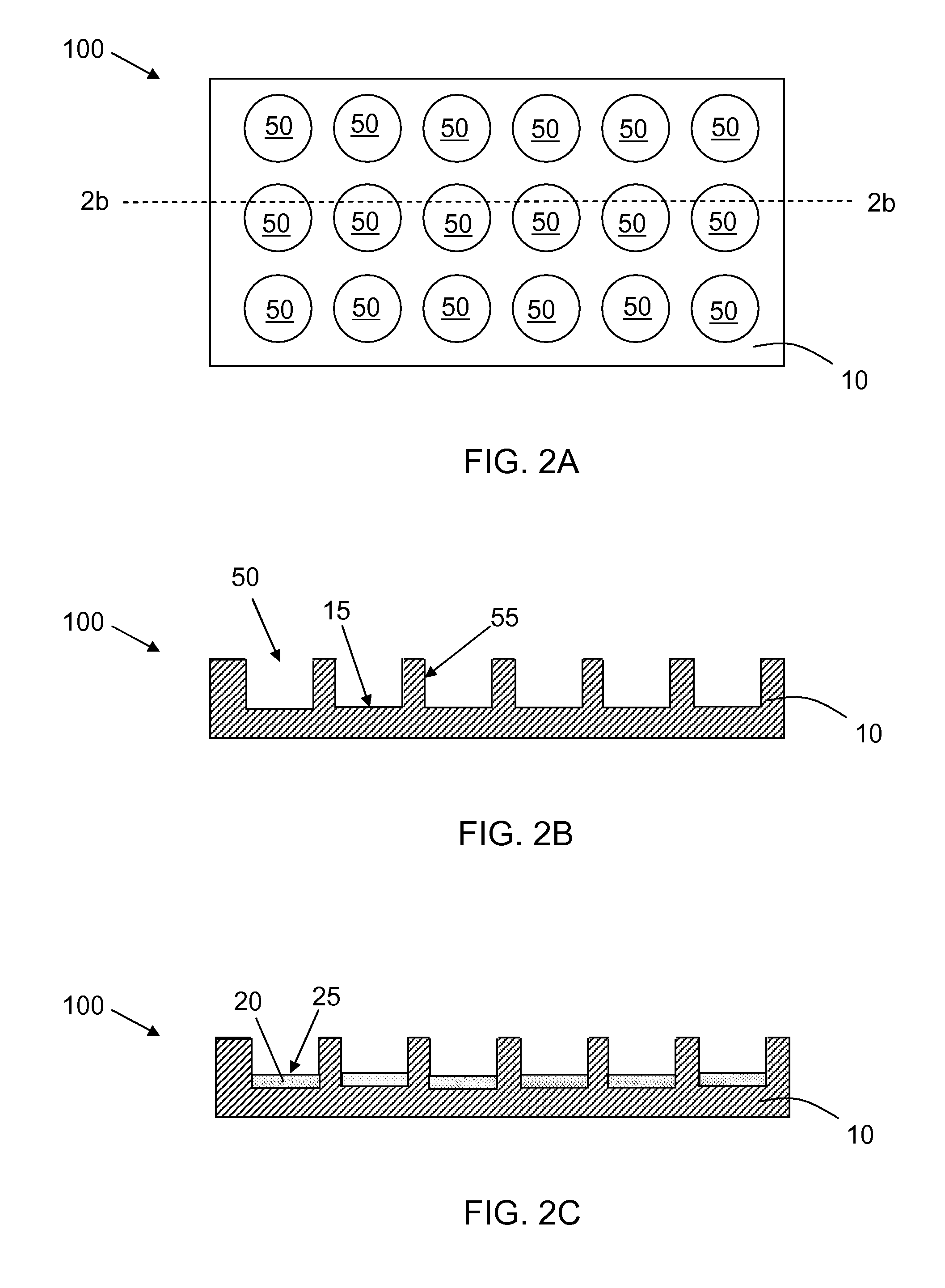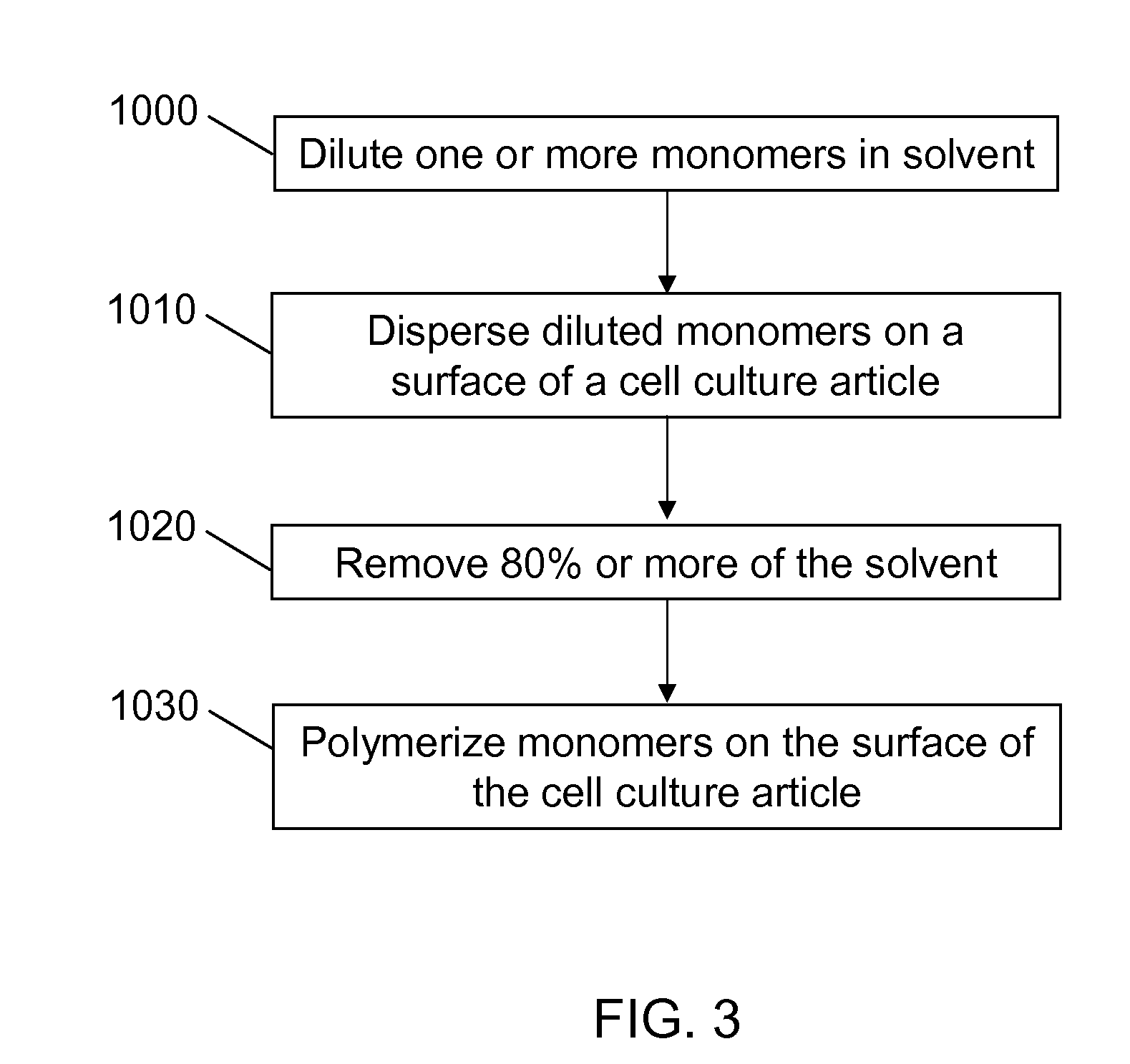Cell culture article and screening
a cell culture and article technology, applied in the field of cell culture articles and methods for producing surfaces, can solve the problems of reducing the possibility of coating surface delamination from the substrate, and achieve the effects of promoting monomer spreading, reducing viscosity, and saving time and labor
- Summary
- Abstract
- Description
- Claims
- Application Information
AI Technical Summary
Benefits of technology
Problems solved by technology
Method used
Image
Examples
example 1
Mild UV Curing and Cyclic Olefin Substrate Increases Layer Uniformity and Decreases Toxicity
Introduction:
[0114]In this example, monomers are deposited on treated polymeric substrates and are polymerized to obtain uniform coating with little or no cytotoxicity. The coating substrates are cell culture vessels made of polymers, which are suitable for cell culture and stable when contacted with coating monomers. The substrate surfaces were vacuum plasma treated with oxygen to promote monomer spreading. (Meth)acrylate homopolymers and copolymers were employed to produce a synthetic polymeric coating layer on a surface of the culture vessel. The monomers were cured under the protection of inert gas to prevent oxygen-inhibition. The uniformity of the synthetic polymer layer and the cytotoxicity of the resultant layer were examined.
Materials, Methods and Results:
[0115]A layer of homopolymer of tetra(ethylene glycol) diacrylate was coated on Tissue Culture Treated (TCT) polystyrene (Corning,...
example 2
High Throughput Screening Photopolymer Process for Cell Culture
[0127]This example provides the basis for a highly efficient solvent-based process for generating synthetic polymer surfaces from a large diversity of monomers that is applicable to large area cell culture wares.
Materials, Methods, and Results:
[0128]A layer of homopolymer of tetra(ethylene glycol) diacrylate was coated in a 96-well cyclic olefin copolymer plate using different ethanol processes. Briefly, Tetra(ethylene glycol) diacrylate (Sigma-Aldrich, Inc) was first mixed with 1% w / v (photoinitiator / monomer) of photoinitiator Irgacure 819 (Ciba Specialty Chemicals, Inc.) and 1 / 1 or 9 / 1 (ethanol[volume] / monomer[volume]) of ethanol depending on experimental design. Then 5 μl of the prepared formulation (monomer, photoinitiator and ethanol) was deposited in each well of plasma treated 96-well cyclic olefin copolymer plate using BioTek Precision Microplate Pipetting System. The formulation solutions spread immediately and ...
example 3
Human Embryonic Stem Cell Screening
Materials and Methods:
[0142]Acrylate surfaces prepared using ethanol as a solvent have been screened for human embryonic stem cell attachment and growth. Briefly, the majority and minority monomers as shown in Table 4 were blended according to the volume ratios of 70:30 and mixed with 1% w / v (photoinitiator / total monomers) of photoinitiator Irgacure 819 and 9 / 1 (ethanol[volume] / total monomer[volume]) of ethanol. Then 5 μl of the prepared formulation (monomer, photoinitiator and ethanol) was deposited in each well of plasma treated 96-well cyclic olefin copolymer plate using BioTek® Precision Microplate Pipetting System. The formulation spread immediately and the plate was allowed horizontal flat in fume hood for 3 hr for the ethanol to evaporate. The coatings were then cured with 13 mW / cm2 pulsed (100 Hz) UV light (Xenon RC-801) for 1 min in N2 purged box (with fused silica window). After curing, a washing step was performed. Briefly, the surface i...
PUM
| Property | Measurement | Unit |
|---|---|---|
| boiling point | aaaaa | aaaaa |
| boiling point | aaaaa | aaaaa |
| boiling point | aaaaa | aaaaa |
Abstract
Description
Claims
Application Information
 Login to View More
Login to View More - R&D
- Intellectual Property
- Life Sciences
- Materials
- Tech Scout
- Unparalleled Data Quality
- Higher Quality Content
- 60% Fewer Hallucinations
Browse by: Latest US Patents, China's latest patents, Technical Efficacy Thesaurus, Application Domain, Technology Topic, Popular Technical Reports.
© 2025 PatSnap. All rights reserved.Legal|Privacy policy|Modern Slavery Act Transparency Statement|Sitemap|About US| Contact US: help@patsnap.com



